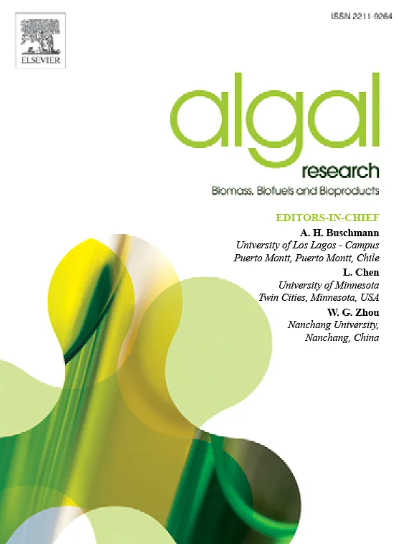产碳水化合物菌株的评价:lewinii小球藻FwC1在不同营养模式和露天池塘条件下的潜力
IF 4.6
2区 生物学
Q1 BIOTECHNOLOGY & APPLIED MICROBIOLOGY
Algal Research-Biomass Biofuels and Bioproducts
Pub Date : 2025-04-17
DOI:10.1016/j.algal.2025.104050
引用次数: 0
摘要
基于微藻的碳水化合物已被确定为第三代生物燃料生产的潜在原料,但从菌株选择到大规模生产存在一些限制。因此,确定一个合适的微藻细胞工厂大规模生产碳水化合物是至关重要的。本研究采用多标准筛选方法筛选了8株藻类,结果表明,在光自养条件下,lewinii小球藻(Chlorella lewinii FwC1)的碳水化合物产量为19.76 mg L−1 day−1,生物量产量为0.15 g mol−1 photon,是最有效的。该菌株在不同温度(24-36°C)和pH(5.5-10.5)下繁殖。在与葡萄糖混合营养条件下,其生物量和碳水化合物产量分别达到414和208 mg L−1 day−1,显著超过异养和光自养生长。在光自养条件下,添加碳酸氢钠可使生物量提高约2倍,在混合营养条件下可提高1.67倍。此外,优化光自养条件将生物量和碳水化合物产量分别提高到190和64.6 mg L−1 day−1,生物量产量为0.38 g mol−1 photon。在300 L露天池塘条件下,最优培养基组成下,生物量产量达到100.2 mg L−1 day−1,碳水化合物产量达到34.5 mg L−1 day−1。因此,lewinii小球藻FwC1是一个很有前途的碳水化合物生产候选者。本文章由计算机程序翻译,如有差异,请以英文原文为准。
Evaluation of algal strains for carbohydrate production: Potentials of Chlorella lewinii FwC1 under different trophic modes and in open-pond conditions
Microalgae-based carbohydrates have been identified as a potential feedstock for third-generation biofuel production, but with several limitations from strain selection to mass production. Thus, identifying an appropriate microalgal cellular factory for mass-scale production of carbohydrates is essential. The present study screened eight algal strains with a multi-criteria approach, identifying Chlorella lewinii FwC1 as the most effective, with carbohydrate productivity of 19.76 mg L−1 day−1 and biomass yield of 0.15 g mol−1 photon under photoautotrophic conditions. This strain thrived across various temperatures (24–36 °C) and pH (5.5–10.5). Under mixotrophic conditions with glucose, it achieved maximum biomass and carbohydrate productivity of 414 and 208 mg L−1 day−1, respectively, significantly surpassing heterotrophic and photoautotrophic growth. Sodium bicarbonate supplementation enhanced biomass productivity by ∼2-fold under photoautotrophic and 1.67-fold under mixotrophic conditions. Further, optimization of photoautotrophic condition improved biomass and carbohydrate productivity to 190 and 64.6 mg L−1 day−1, respectively, with a biomass yield of 0.38 g mol−1 photon. Under open-pond conditions at a 300 L scale with optimal media composition, productivity reached 100.2 mg L−1 day−1 for biomass and 34.5 mg L−1 day−1 for carbohydrates. Thus, Chlorella lewinii FwC1 is a promising candidate for carbohydrate production.
求助全文
通过发布文献求助,成功后即可免费获取论文全文。
去求助
来源期刊

Algal Research-Biomass Biofuels and Bioproducts
BIOTECHNOLOGY & APPLIED MICROBIOLOGY-
CiteScore
9.40
自引率
7.80%
发文量
332
期刊介绍:
Algal Research is an international phycology journal covering all areas of emerging technologies in algae biology, biomass production, cultivation, harvesting, extraction, bioproducts, biorefinery, engineering, and econometrics. Algae is defined to include cyanobacteria, microalgae, and protists and symbionts of interest in biotechnology. The journal publishes original research and reviews for the following scope: algal biology, including but not exclusive to: phylogeny, biodiversity, molecular traits, metabolic regulation, and genetic engineering, algal cultivation, e.g. phototrophic systems, heterotrophic systems, and mixotrophic systems, algal harvesting and extraction systems, biotechnology to convert algal biomass and components into biofuels and bioproducts, e.g., nutraceuticals, pharmaceuticals, animal feed, plastics, etc. algal products and their economic assessment
 求助内容:
求助内容: 应助结果提醒方式:
应助结果提醒方式:


